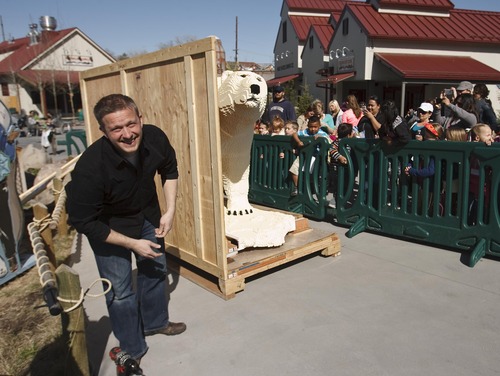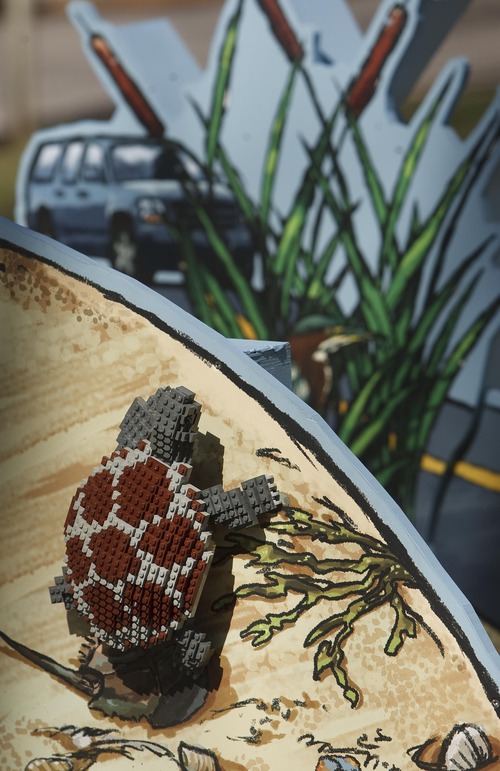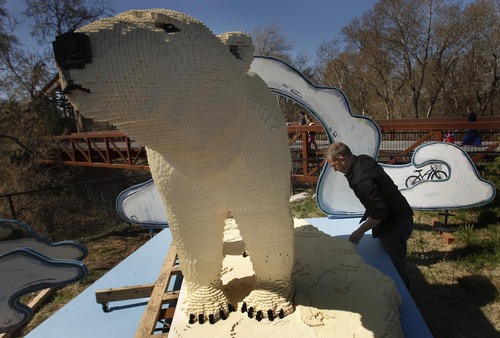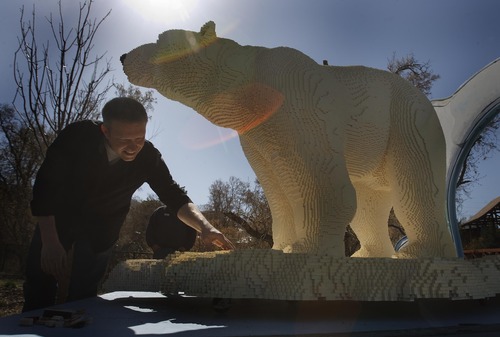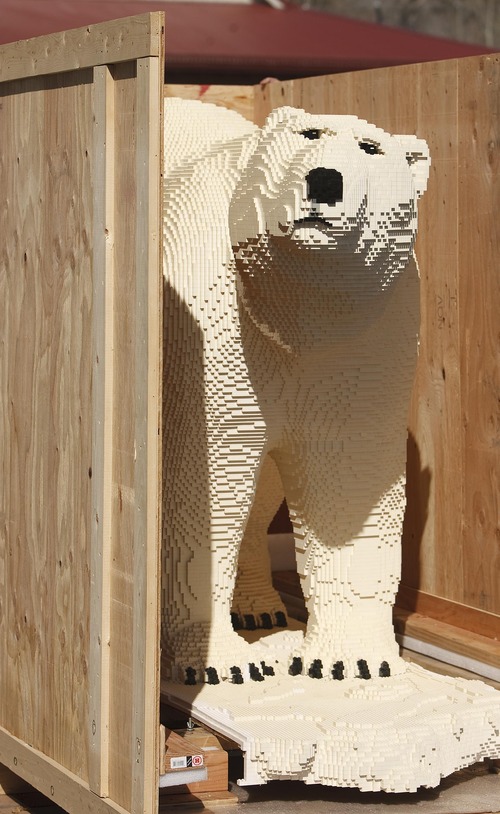This is an archived article that was published on sltrib.com in 2013, and information in the article may be outdated. It is provided only for personal research purposes and may not be reprinted.
Adam Vialpando hoisted his 6-year-old daughter, Gwen, onto his shoulders, then handed her his cellphone so she could take a picture of whatever came out of the wooden crate at Utah's Hogle Zoo.
"A polar bear," she predicted excitedly, moments before the front panel came off. Sure enough, it was a life-size polar bear — but one formed by 95,000 Legos rather than muscle, teeth and a yen to eat.
"If it was a real polar bear, I'd just scream," Gwen told her dad, of West Valley City.
But there was no screaming Wednesday. Mostly just oohs and aahs at the unveiling of the 400-pound polar bear, one of nine displays of Lego animals that will be scattered about the zoo this season for its exhibit, "Creatures of Habitat — A Gazillion-Piece Animal Adventure."
"That's so cool. It's amazing," marveled Carolina Smith, a chaperone for students from Heber Valley Elementary in Wasatch County.
Zoo officials expect the exhibition, on loan from the Philadelphia Zoo, to elicit similar responses from now through September. They also hope the plastic caricatures of frogs and turtles, gorillas and kingfishers, will make an impression on children whose familiarity with Legos leaves them more receptive to ideas about the exhibit's message: the need to protect critical habitats for these creatures.
At the unveiling was Sean Kenney, in his own words age 36 going on 12, a New York City artist whose studio the Philadelphia Zoo commissioned to create the display.
"How long do you think it took to make this?" Kenney asked onlookers, including many moms pushing strollers and trying to keep preschoolers corralled. Two days was the first guess. Thirty minutes was another.
"How about the first day of summer vacation to New Year's Day. All day, every day, build, build, build," said Kenney, noting that his staff of seven — sculptors, architects, a geometric painter and mixed-media specialists — spent 1,100 hours gluing together Legos in a shape that almost brought the plastic polar bear to life. Four months were spent building the whole exhibit, which included 259,450 Lego bricks.
"We spent two days just on the polar bear's eyes," said Kenney, one of 13 Lego certified professionals in the world, of the painstaking effort to develop animals that are anatomically accurate and exude personality at the same time.
A dozen monkeys — golden lion tamarins to be precise — took hours upon hours to develop for an exhibit about the loss of tree-top habitat in the Brazilian rain forest. "Their faces are small but expressive," Kenney said, laughing about once having a desk covered with prototype monkey heads. "We really wanted to capture their facial features."
He has two other Lego exhibits on tour — "Nature Connects," now in Omaha on a tour of botanical gardens, and "Big League, Little Bricks," a baseball-themed exhibit at the Louisville Slugger Museum & Factory.
Twitter: @sltrib.com The message behind the 'Creatures of Habitat' Lego exhibit
Lego brick animals in the "Creatures of Habitat" exhibit this spring and summer at Utah's Hogle Zoo were created to educate people about things they can do to help preserve endangered species and their disappearing habitats, such as:
Power down • Conserve energy, fight global warming, save the polar bear.
Swing into action • Be aware of products that use palm oil, taken from felled trees crucial to orangutans.
Recycle and discard things properly • Frog populations are declining as jetsam clogs their habitat.
Answer the call • Recycle cellphones to protect African gorillas, whose homelands are mined for the metallic ore coltan, which goes into the phone.
Plant for the future • Participate in plans to plant a million trees in Salt Lake County in the next decade.
Keep tortoises trucking • Don't take animals, such as Utah's desert tortoise, out of their natural habitats.
Angling to save fish • Avoid eating types of fish important to penguins.
Leaf out for wildlife • Look for the Forest Stewardship Council logo when buying wood, paper products.
Be wild aware • Put a bell on your cat's collar to scare away birds that otherwise would be prey.


